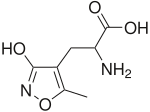Homocysteic acid is the organosulfur compound with the formula HO3SCH2CH2CH(NH2)CO2H. A white solid, it is sulfonic acid-containing non-proteinogenic amino...
2 KB (175 words) - 10:05, 27 December 2023
Glutamic acid (symbol Glu or E; the anionic form is known as glutamate) is an α-amino acid that is used by almost all living beings in the biosynthesis...
35 KB (3,237 words) - 17:07, 11 September 2024
Domoic acid (DA) is a kainic acid-type neurotoxin that causes amnesic shellfish poisoning (ASP). It is produced by algae and accumulates in shellfish,...
20 KB (1,834 words) - 15:19, 18 September 2024
Muscimol (redirect from Ibonetic acid)
present in trace amounts and it is not active), muscazone, and ibotenic acid. In A. muscaria, the layer just below the skin of the cap contains the highest...
37 KB (3,825 words) - 21:25, 7 October 2024
7-Dichlorokynurenic acid (DCKA) is a selective NMDA receptor antagonist acting at the glycine site of the NMDA receptor complex. 7-Chlorokynurenic acid Kynurenic acid McNamara...
2 KB (66 words) - 15:17, 20 April 2021
Glycine (redirect from Aminoethanoic acid)
/ˈɡlaɪsiːn/ ) is an amino acid that has a single hydrogen atom as its side chain. It is the simplest stable amino acid (carbamic acid is unstable). Glycine...
40 KB (3,766 words) - 11:02, 30 October 2024
1-Aminocyclopropane-1-carboxylic acid (ACC) is a disubstituted cyclic α-amino acid in which a cyclopropane ring is fused to the Cα atom of the amino acid. It is a white...
7 KB (638 words) - 16:14, 6 October 2024
Clavulanic acid is a β-lactam drug that functions as a mechanism-based β-lactamase inhibitor. While not effective by itself as an antibiotic, when combined...
24 KB (2,140 words) - 02:36, 10 November 2024
N-methyl-D-aspartic acid or N-methyl-D-aspartate (NMDA) is an amino acid derivative that acts as a specific agonist at the NMDA receptor mimicking the...
12 KB (988 words) - 20:01, 15 August 2024
aspartic acid is one of the 22 proteinogenic amino acids, i.e., the building blocks of proteins. D-aspartic acid is one of two D-amino acids commonly...
19 KB (1,699 words) - 08:58, 7 November 2024
Kainate receptor (redirect from Receptors, kainic acid)
Kainate receptors, or kainic acid receptors (KARs), are ionotropic receptors that respond to the neurotransmitter glutamate. They were first identified...
11 KB (1,263 words) - 21:34, 11 June 2024
NMDA receptor (redirect from N-methyl-D-aspartic acid receptor)
D-aspartate. Glutamic acid (glutamate) – endogenous glutamate site agonist Tetrazolylglycine – synthetic glutamate site agonist Homocysteic acid – endogenous glutamate...
107 KB (12,058 words) - 11:59, 2 November 2024
Alanine (redirect from 2-Aminopropanoic acid)
α-alanine, is an α-amino acid that is used in the biosynthesis of proteins. It contains an amine group and a carboxylic acid group, both attached to the...
23 KB (2,182 words) - 18:28, 14 June 2024
Miller–Urey experiment (category Chemical synthesis of amino acids)
electric arc (simulating lightning) resulted in the production of amino acids. It is regarded as a groundbreaking experiment, and the classic experiment...
70 KB (7,004 words) - 20:33, 31 October 2024
γ-aminobutyraldehyde (GABAL), N-acetyl-γ-aminobutyric acid (N-acetyl-GABAL), and N-acetyl-γ-aminobutyric acid (N-acetyl-GABA), biotransformations mediated by...
23 KB (2,185 words) - 19:05, 30 September 2024
catalyzes the hydrolysis of S-D-lactoylglutathione to glutathione and D-lactic acid. It maintains exogenous antioxidants such as vitamins C and E in their reduced...
25 KB (2,681 words) - 12:59, 4 October 2024
Ibotenic acid or (S)-2-amino-2-(3-hydroxyisoxazol-5-yl)acetic acid, also referred to as ibotenate, is a chemical compound and psychoactive drug which...
16 KB (1,473 words) - 00:34, 20 July 2024
The α-amino-3-hydroxy-5-methyl-4-isoxazolepropionic acid receptor (also known as AMPA receptor, AMPAR, or quisqualate receptor) is an ionotropic transmembrane...
60 KB (7,024 words) - 22:23, 19 October 2024
di-(β-D-gentiobiosyl) ester; it bears the systematic (IUPAC) name 8,8-diapo-8,8-carotenoic acid. This means that the crocin underlying saffron's aroma is a digentiobiose...
70 KB (7,822 words) - 12:22, 15 November 2024
AMPA (redirect from Α-Amino-3-hydroxy-5-methyl-4-isoxazolepropionic acid)
α-amino-3-hydroxy-5-methyl-4-isoxazolepropionic acid, better known as AMPA, is a compound that is a specific agonist for the AMPA receptor, where it mimics...
4 KB (274 words) - 13:44, 20 January 2024
Pentobarbital (redirect from 5-ethyl-5-(1-methylbutyl)-barbituric acid)
Pentobarbital can occur as a free acid, but is usually formulated as the sodium salt, pentobarbital sodium. The free acid is only slightly soluble in water...
22 KB (1,980 words) - 09:28, 17 November 2024
magnesium-based engine. Magnesium also reacts exothermically with most acids such as hydrochloric acid (HCl), producing magnesium chloride and hydrogen gas, similar...
78 KB (8,529 words) - 22:51, 8 November 2024
agonists: AMAA Aspartate Glutamate Homocysteic acid (L-HCA) Homoquinolinic acid Ibotenic acid NMDA Proline Quinolinic acid Tetrazolylglycine Theanine; Glycine...
2 KB (142 words) - 12:42, 10 March 2023
2-Pyrrolidinone and p-anisic acid (20–30%). There is some preliminary research suggesting that N-anisoyl-GABA and to a lesser degree p-ansic acid may contribute to...
13 KB (1,185 words) - 16:33, 23 September 2024
of ethylene to make ethanol. This process uses solid-supported phosphoric acid catalysts and can be adjusted to make more ether if the need arises: Vapor-phase...
27 KB (2,445 words) - 05:23, 23 November 2024
agonists: AMAA Aspartate Glutamate Homocysteic acid (L-HCA) Homoquinolinic acid Ibotenic acid NMDA Proline Quinolinic acid Tetrazolylglycine Theanine; Glycine...
2 KB (166 words) - 09:29, 5 September 2024
Chloroform (section Lewis acid)
an obsolete name for the methylylidene radical (CH) derived from formic acid. Many kinds of seaweed produce chloroform, and fungi are believed to produce...
61 KB (5,773 words) - 20:17, 17 November 2024
Hyoscyamine/hexamethylenetetramine/phenyl salicylate/methylene blue/benzoic acid is a prescription drug combination used to treat pain caused by urinary tract...
47 KB (5,008 words) - 04:15, 20 October 2024
GABA and shares the same 2-oxo-pyrrolidone base structure with pyroglutamic acid. Related drugs include the anticonvulsants levetiracetam and brivaracetam...
24 KB (2,346 words) - 06:35, 1 October 2024
Bumetanide (category Benzoic acids)
4-chlorobenzoic acid. In the first stage of synthesis, it undergoes sulfonylchlorination by chlorosulfonic acid, forming 4-chloro-3-chlorosulfonylbenzoic acid, which...
14 KB (1,371 words) - 21:27, 10 March 2024




























